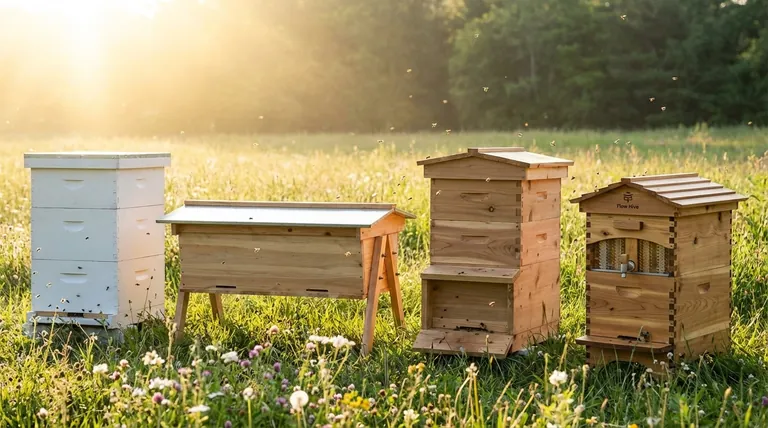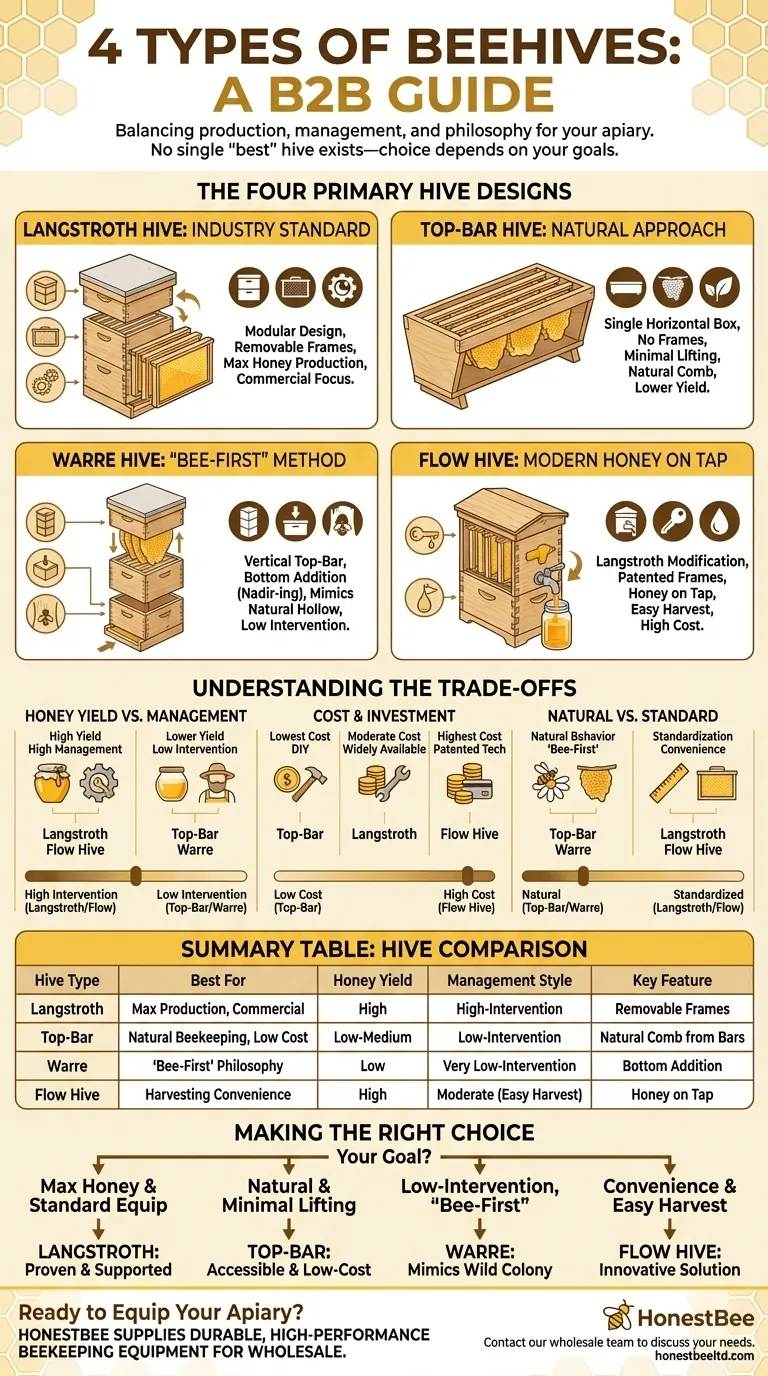While there are many variations, the four most recognized types of beehives are the Langstroth, the Top-Bar, the Warre, and the Flow Hive. Each design is built around a different philosophy of beekeeping, balancing factors like honey production, ease of management, and alignment with the bees' natural behaviors.
The "best" beehive does not exist. The right choice depends entirely on your goals as a beekeeper—whether you prioritize maximum honey yield, a more natural and low-intervention approach, or the convenience of modern technology.

The Four Primary Hive Designs Explained
Understanding the fundamental design of each hive is the key to choosing the one that fits your purpose. The core difference lies in how they manage space and how the beekeeper interacts with the comb.
The Langstroth Hive: The Industry Standard
The Langstroth is the most common beehive in the world. Its design is modular, consisting of stacked boxes that can be added or removed to match the colony's size and honey flow.
Inside these boxes, bees build their comb on removable frames. These frames are what allow for easy inspection, management, and honey extraction, making the Langstroth the standard for commercial and large-scale hobbyist honey production.
Frames are typically fitted with a foundation—a sheet of wax or plastic—to guide comb construction. Plastic foundations are durable and pest-resistant, while beeswax is more natural but fragile.
The Top-Bar Hive: A More Natural Approach
The Top-Bar hive is a single, long horizontal box. Instead of full frames, it uses simple wooden bars across the top from which bees hang their comb naturally.
This design is considered less intrusive, as a beekeeper only needs to inspect one comb at a time without disturbing the entire hive. It promotes natural comb building and requires less heavy lifting since you are not moving heavy boxes.
However, the comb is not supported by a frame, making it more fragile and difficult to use in a mechanical honey extractor.
The Warre Hive: The Vertical "Bee-First" Method
The Warre hive, sometimes called "the people's hive," is a vertical top-bar hive. Its philosophy is to mimic the way bees live in a natural tree hollow.
Instead of adding boxes to the top (supering), new boxes are added to the bottom (nadir-ing). This encourages the colony to build its comb downward, as it would in nature. It is designed for very low intervention.
The Flow Hive: Modern Honey on Tap
The Flow Hive is a revolutionary modification of the Langstroth design. It uses standard Langstroth boxes but replaces the honey storage frames with a patented technology.
These special frames contain pre-formed plastic honeycomb cells that can be split open with the turn of a key. This allows pure, filtered honey to flow directly out of the hive into a jar without opening the hive, smoking the bees, or processing any comb.
Understanding the Trade-offs
Choosing a hive involves balancing honey yield, management style, cost, and beekeeping philosophy. There is no single hive that excels in all areas.
Honey Yield vs. Management Intensity
The Langstroth and Flow Hive are designed to maximize honey production. Their standardized, interchangeable frames make management and extraction highly efficient, but this often requires more frequent inspections and manipulation.
Top-Bar and Warre hives typically produce less surplus honey. They are designed for a "bee-first," lower-intervention style of beekeeping where the beekeeper interferes with the colony as little as possible.
Cost and Initial Investment
Top-Bar hives are often the least expensive and can even be a straightforward DIY project. Langstroth hives represent a moderate investment but have the widest availability of parts.
The Flow Hive is by far the most expensive option due to its patented honey-extraction technology. While it saves labor during harvest, the initial cost is a significant factor for new beekeepers.
Natural Behavior vs. Standardization
The Top-Bar and Warre hives are built to more closely honor the bees' natural instincts. They allow bees to build their own comb size and shape, which some believe contributes to better colony health.
Conversely, the Langstroth hive's foundation-based frames standardize the hive for the beekeeper's convenience. This makes inspections and honey harvesting predictable but gives the bees less control over their environment.
Making the Right Choice for Your Beekeeping Goals
Your personal goals should be the deciding factor. Analyze what you want to achieve before you invest in equipment.
- If your primary focus is maximizing honey production and using standard equipment: The Langstroth hive is the proven, most widely supported choice.
- If your primary focus is natural beekeeping with minimal heavy lifting: The Top-Bar hive offers an accessible, low-cost entry point.
- If your primary focus is a low-intervention, "bee-first" philosophy: The Warre hive's design best mimics a wild colony's natural development.
- If your primary focus is convenience and harvesting honey with minimal disturbance: The Flow Hive provides an innovative, albeit expensive, solution.
Ultimately, the best hive is the one that aligns with your philosophy and keeps you engaged and excited about the craft of beekeeping.
Summary Table:
| Hive Type | Best For | Honey Yield | Management Style | Key Feature |
|---|---|---|---|---|
| Langstroth | Maximum honey production, commercial use | High | High-intervention, modular | Removable frames for easy inspection |
| Top-Bar | Natural beekeeping, low cost | Low-Medium | Low-intervention, minimal lifting | Bees build natural comb from bars |
| Warre | 'Bee-first' philosophy, low disturbance | Low | Very low-intervention | New boxes added to the bottom |
| Flow Hive | Harvesting convenience, modern technology | High | Moderate (easy harvest) | Honey on tap via patented frames |
Ready to Equip Your Apiary with the Right Hive?
As a commercial beekeeper or distributor, choosing the right equipment is critical for the health of your colonies and the success of your operation. HONESTBEE supplies durable, high-performance beekeeping supplies and equipment through our wholesale-focused operations.
We provide the reliable foundation—from Langstroth components to essential tools—that commercial apiaries and distributors depend on.
Contact our wholesale team today to discuss your specific needs and learn how our equipment can support your scale and goals.
Visual Guide

Related Products
- Long Langstroth Style Horizontal Top Bar Hive for Wholesale
- Langstroth Bee Hives Bee Keeping Box for Beginners Beekeeping
- Honey Flow Garden Bee Hive Flow Hive Best Beehive for Beginners
- HONESTBEE Advanced Ergonomic Stainless Steel Hive Tool for Beekeeping
- HONESTBEE Professional Long Handled Hive Tool with Precision Cutting Blade
People Also Ask
- What is a top bar bee hive? A Natural, Low-Stress Beekeeping Solution
- How are entrances designed in top bar hives? Master Beehive Layout for Maximum Honey
- What are the advantages of a top bar hive? Simpler, Bee-Centric Beekeeping for All
- What are the main differences between Langstroth hives and top bar hives? Choose the Right Hive for Your Beekeeping Goals
- How does the design of a top bar hive benefit beekeepers? Ergonomic & Natural Beekeeping for Hobbyists



















